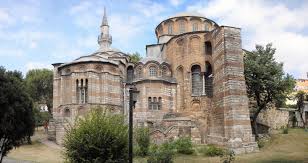| Chora Church (Kariye Camii in Turkish) is the most interesting Byzantine church after Hagia Sophia in Istanbul. The importance of the church does not come from the building itself , the frescoes and the mosaics are superb and reflect the magnificent heritage of Byzantine Art. The Chora Church Museum is open every day from 9 a.m to 4:30 p.m except Wednesday.
There are no remains left from the original church and the first form of the present structure dates back to 11C. The church was founded by Maria Doukaina, mother-in-law of Alexius Comnenos I between 1077-1081. Today’s church was constructed after two centuries, the walls were reverted with superb mosaics and a pareclession was added decorated with beautiful frescoes. The founder of the church was Theodore Metochites. He was also an astronomer, poet, theologian and philosopher. Actually he lived a very sad life, after Palaeologus was replaced by another emperor, he was sent to exile. After he came back to Constantinople, he devoted himself to the church as a monk and he died there. Early in the 16C, the church was converted to a mosque by Attic Ali Pasha and the mosaics were covered with plaster. In 1948, it was restored by Byzantine Institute of America and opened as a museum in 1958.
The mosaics in Chora Museum dates back to 14th C and they can be divided into 4 parts, the ones on the nave, outer narthex entrance), inner narthex and frescoes in pareclession (funerary chapel)
Nave; (1) Koimesis, the Dormition of the Virgin. Before ascending to Heaven, her last sleep. Jesus is holding an infant, symbol of Mary’s soul; (2) Jesus Christ; (3) The Virgin Mary.
Inner Narthex; (4) The Enthroned Christ with the Donor, Theodore Metochites presenting a model of his church; (5) St. Peter; (6) St. Paul; (7) Deesis, Christ and the Virgin Mary (without St. John the Baptist) with two donors below; (8) Genealogy of Christ; (9) Religious and noble ancestors of Christ.
Outer Narthex; (25) Joseph’s dream and journey to Bethlehem; (26) Enrollment for taxation; (27) Nativity, birth of Christ; (28) Journey of the Magi; (29) Inquiry of King Herod; (30) Flight into Egypt; (31-32) Massacres ordered by King Herod; (33) Mothers mourning for their children; (34) Flight of Elizabeth, mother of St. John the Baptist; (35) Joseph dreaming, Return of the holy family from Egypt to Nazareth; (36) Christ taken to Jerusalem for the Passover; (37) St. John the Baptist bearing witness to Christ; (38) Miracle; (39-41) Miracles.(45) Jesus Christ; (46) The Virgin and Angels praying.
Parecclesion; The pictures here are frescoes. This chapel was designed to be a burial place. Among the major frescoes in the parecclesion are as follows: (47) Anastasis, the Resurrection. Christ, who had just broken down the gates of Hell, is standing in the middle and trying to pull Adam and Eve out of their tombs. Behind Adam stand St. John the Baptist, David and Solomon. Others are righteous kings; (48) The Second coming of Christ, the last judgment. Jesus is enthroned and on both sides the Virgin Mary and St. John the Baptist (this trio is also called the Deesis); (49) The Virgin and Child; (50) Heavenly Court of Angels; (51-52) Moses. |

